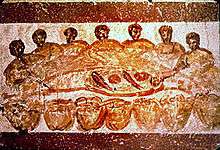Catacombs of Rome
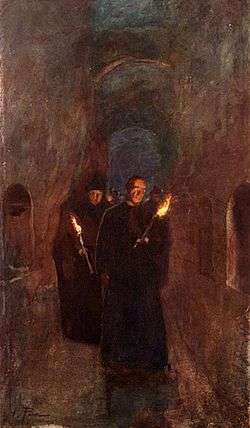

The Catacombs of Rome (Italian: Catacombe di Roma) are ancient catacombs, underground burial places under Rome, Italy, of which there are at least forty, some discovered only in recent decades. Though most famous for Christian burials, either in separate catacombs or mixed together, people of all the Roman religions are buried in them, beginning in the 2nd century AD,[1] mainly as a response to overcrowding and shortage of land. The Etruscans, like many other European peoples, used to bury their dead in underground chambers. The original Roman custom was cremation, after which the burnt remains were kept in a pot, ash-chest or urn, often in a columbarium. From about the 2nd century AD, inhumation (burial of unburnt remains) became more fashionable, in graves or sarcophagi, often elaborately carved, for those who could afford them. Christians also preferred burial to cremation because of their belief in bodily resurrection at the Second Coming.
The Christian catacombs are extremely important for the art history of Early Christian art, as they contain the great majority of examples from before about 400 AD, in fresco and sculpture, as well as gold glass medallions (these, like most bodies, have been removed). The Jewish catacombs are similarly important for the study of Jewish culture at this period. A number of dubious relics of catacomb saints were promoted after the rediscovery of the catacombs.
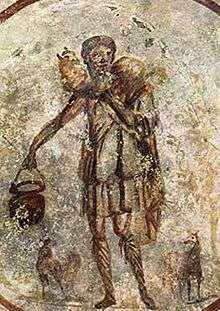
Precursors
The Etruscans, like many other European people, used to bury their dead in underground chambers. The original Roman custom was cremation, after which the burnt remains were kept in a pot, ash-chest or urn, often in a columbarium. From about the 2nd century AD, inhumation (burial of unburnt remains) became more fashionable, in graves or sarcophagi, often elaborately carved, for those who could afford them.[1] Christians also preferred burial to cremation because of their belief in bodily resurrection.
Christian catacombs
The first large-scale catacombs in the vicinity of Rome were excavated from the 2nd century onwards. They were carved through tufo,[2] a soft volcanic rock, outside the walls of the city, because Roman law forbade burial places within city limits. The pagan custom was to incinerate corpses, while early Christians and Jews buried the dead. Since most Christians and Jews at that time belonged to the lower classes or were slaves, they usually lacked the resources to buy land for burial purposes. Instead, networks of tunnels were dug in the deep layers of tufo which occurred naturally on the outskirts of Rome. At first, these tunnels were probably not used for regular worship, but simply for burial and, extending pre-existing Roman customs, for memorial services and celebrations of the anniversaries of Christian martyrs. There are sixty known subterranean burial chambers in Rome. They were built outside the walls along main Roman roads, like the Via Appia, the Via Ostiense, the Via Labicana, the Via Tiburtina, and the Via Nomentana. Names of the catacombs – like St Calixtus and St Sebastian, which is alongside Via Appia – refer to martyrs that may have been buried there. About 80% of the excavations used for Christian burials date to after the time of the persecutions.[3]
Excavators (fossors), no doubt slaves, built vast systems of galleries and passages on top of each other. They lie 7–19 metres (23–62 ft) below the surface in an area of more than 2.4 square kilometres (590 acres). Narrow steps that descend as many as four stories join the levels. Passages are about 2.5 by 1 metre (8.2 ft × 3.3 ft). Burial niches (loculi) were carved into walls. They are 40–60 centimetres (16–24 in) high and 120–150 centimetres (47–59 in) long. Bodies were placed in chambers in stone sarcophagi in their clothes and bound in linen. Then the chamber was sealed with a slab bearing the name, age and the day of death. The fresco decorations provide the main surviving evidence for Early Christian art, and initially show typically Roman styles used for decorating homes - with secular iconography adapted to a religious function. The catacomb of Saint Agnes is a small church. Some families were able to construct cubicula which would house various loculi and the architectural elements of the space would offer a support for decoration. Another excellent place for artistic programs were the arcosolia.
Decline and rediscovery
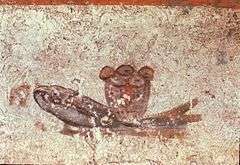
In 380, Christianity became a state religion. At first, many still desired to be buried in chambers alongside the martyrs. However, the practice of catacomb burial declined slowly, and the dead were increasingly buried in church cemeteries. In the 6th century catacombs were used only for martyrs’ memorial services, though some paintings were added as late as the 7th century, for example a Saint Stephen in the Catacomb of Commodilla. Apparently Ostrogoths, Vandals and Lombards that sacked Rome also violated the catacombs, presumably looking for valuables. By the 10th century catacombs were practically abandoned, and holy relics were transferred to above-ground basilicas.
In the intervening centuries they remained forgotten until they were accidentally rediscovered in 1578, after which Antonio Bosio spent decades exploring and researching them for his volume, Roma Sotterranea (1632). Archeologist Giovanni Battista de Rossi (1822–1894) published the first extensive professional studies about catacombs. In 1956 and 1959 Italian authorities found more catacombs near Rome. The catacombs have become an important monument of the early Christian church.
Today
Currently, maintenance of the catacombs is in the hands of the papacy, which has invested in the Salesians of Don Bosco the supervision of the Catacombs of St. Callixtus on the outskirts of Rome.
Responsibility for the Christian catacombs lies with the Pontifical Commission of Sacred Archaeology (Pontificia Commissione di Archeologia Sacra), which directs excavations and restorations. Study of the catacombs is directed by the Pontifical Academy of Archaeology.
Typology
Roman catacombs are made up of underground passages (ambulacra), out of whose walls graves (loculi) were dug. These loculi, generally laid out vertically (pilae), could contain one or more bodies. Another type of burial, typical of Roman catacombs, was the arcosolium, consisting of a curved niche, enclosed under a carved horizontal marble slab. Cubicula (burial rooms containing loculi all for one family) and cryptae (chapels decorated with frescoes) are also commonly found in catacomb passages. When space began to run out, other graves were also dug in the floor of the corridors - these graves are called formae.
List of catacombs in Rome
The Roman catacombs, of which there are forty in the suburbs, were built along the consular roads out of Rome, such as the Appian way, the via Ostiense, the via Labicana, the via Tiburtina, and the via Nomentana.
Catacombs of Marcellinus and Peter
These catacombs are situated on the ancient Via Labicana, today Via Casilina in Rome, Italy, near the church of Santi Marcellino e Pietro ad Duas Lauros. Their name refers to the Christian martyrs Marcellinus and Peter who, according to tradition, were buried here, near the body of St. Tiburtius.
Catacombs of Domitilla

Close to the Catacombs of San Callisto are the large and impressive Catacombs of Domitilla[4] (named after Saint Domitilla), spread over 15 kilometres (9 miles) of underground caves.
The Domitilla Catacombs are unique in that they are the oldest of Rome's underground burial networks, and the only ones to still contain bones. They are also the best preserved and one of the most extensive of all the catacombs. Included in their passages are a 2nd-century fresco of the Last Supper and other valuable artifacts.
There are almost 150,000 bodies buried in the Catacombs of St. Domitilla.[5]
They are the only catacombs that have a subterranean basilica; entrance to the catacombs is achieved through this sunken 4th-century church, at via delle Sette Chiese 282. In the past, the basilica had become unsafe, and was abandoned in the 9th century. It was rediscovered in 1593, and much of it was reconstructed in 1872.
In the beginning of 2009,[6] at the request of the Vatican, the Divine Word Missionaries, a Roman Catholic Society of priests and Brothers, assumed responsibility as administrator of St. Domitilla Catacombs.[7]
Catacombs of Commodilla

These catacombs, on the Via Ostiensis, contain one of the earliest images of a bearded Christ. They originally held the relics of Saints Felix and Adauctus.
Catacombs of Generosa
Located on the Campana Road, these catacombs are said to have been the resting place, perhaps temporarily, of Simplicius, Faustinus and Beatrix, Christian Martyrs who died in Rome during the Diocletian persecution (302 or 303).[8]
Catacombs of Praetextatus
These are found along the via Appia, and were built at the end of 2nd century. They consist of a vast underground burial area, at first in pagan then in Christian use, housing various tombs of Christian martyrs. In the oldest parts of the complex may be found the "cubiculum of the coronation", with a rare depiction for that period of Christ being crowned with thorns, and a 4th-century painting of Susanna and the old men in the allegorical guise of a lamb and wolves.
Catacombs of Priscilla
The Catacomb of Priscilla, situated at the Via Salaria across from the Villa Ada, probably derives its name from the name of the landowner on whose land they were built. They are looked after by the Benedictine nuns of Priscilla.
Catacombs of San Callisto

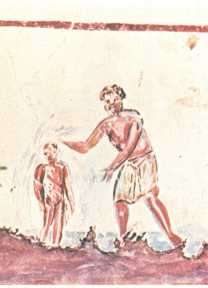
Sited along the Appian way, these catacombs were built after AD 150, with some private Christian hypogea and a funeral area directly dependent on the Catholic Church. It takes its name from the deacon Saint Callixtus, proposed by Pope Zephyrinus in the administration of the same cemetery - on his accession as pope, he enlarged the complex, that quite soon became the official one for the Roman Church. The arcades, where more than fifty martyrs and sixteen pontiffs were buried, form part of a complex graveyard that occupies fifteen hectares and is almost 20 km (12 mi) long.
Catacombs of San Lorenzo
Built into the hill beside San Lorenzo fuori le Mura, these catacombs are said to have been the final resting place of St. Lawrence. The church was built by Pope Sixtus III and later remodeled into the present nave. Sixtus also redecorated the shrine in the catacomb and was buried there.[9]
Catacombs of San Pancrazio
Established underneath the San Pacrazio basilica which was built by Pope Symmachus on the place where the body of the young martyr Saint Pancras, or Pancratius, had been buried. In the 17th century, it was given to the Discalced Carmelites, who completely remodeled it. The catacombs house fragments of sculpture and pagan and early Christian inscriptions.
Catacombs of San Sebastiano

One of the smallest Christian cemeteries, this has always been one of the most accessible catacombs and is thus one of the least preserved (of the four original floors, the first is almost completely gone). On the left hand end of the right hand wall of the nave of the primitive basilica, rebuilt in 1933 on ancient remains, arches to end the middle of the nave of the actual church, built in the 13th century, are visible, along with the outside of the apse of the Chapel of the Relics; whole and fragmentary collected sarcophagi (mostly of 4th century date) were found in excavations.
Via a staircase down, one finds the arcades where varied cubicula (including the cubiculum of Giona's fine four stage cycle of paintings, dating to the end of the 4th century). One then arrives at the restored crypt of S. Sebastiano, with a table altar on the site of the ancient one (some remains of the original's base still survive) and a bust of Saint Sebastian attributed to Bernini. From here one reaches a platform, under which is a sandstone cavity ad catacumbas which once may have been named "ad catacumbas", thus giving this and all other tombs of this type their name. 3 mausolea of the second half of the 2nd century (but also in later use) open off the platform. The first one on the right, decorated on the outside with paintings of funereal banquets and the miracle of the calling out of Cerasa's demons, on the inside contains paintings (including a ceiling painting of a Gorgon's head) and inhumation burials and has a surviving inscription reading "Marcus Clodius Hermes", the name of its owner. The second, called by some "tomb of the Innocentiores" (a burial club which owned it), has a refined stucco ceiling, Latin inscriptions in Greek characters, and a graffito with the initials of the Greek words for "Jesus Christ, Son of God, Saviour". On the left is the mausoleum of Ascia, with an exterior wall painting of vine shoots rising from kantharoi up trompe-l'œil pillars.
A room called the "Triglia" rises from the platform, roughly in the middle of the basilica and cut into from above by the present basilica. This covered room was used for funereal banquets; the plastered walls have hundreds of graffiti by the devotees at these banquets, carved in the second half of the 3rd to the beginnings of the 4th century, with appeals to the apostles Peter and Paul. From the "Trigilia" one passed into an ancient ambulatory, which turns around into an apse: here is a collection of epitaphs and a model of all the mausolei, of the "Triglia" and of the Constantinian basilica. From here one descends into the "Platonica", a construction at the rear of the basilica that was long believed to have been the temporary resting place for Peter and Paul, but was in fact (as proved by excavation) a tomb for the martyr Quirinus, bishop of Sescia in Pannonia, whose remains were brought here in the 5th century. To the right of the "Platonica" is the chapel of Honorius III, adapted as the vestibule of the mausoleum, with interesting 13th-century paintings of Peter and Paul, the Crucifixion, saints, the Massacre of the Innocents, Madonna and Child, and other subjects. On the left is an apsidal mausoleum with an altar built against the apse: on the left wall a surviving graffito reading "domus Petri" either hints at Peter having been buried here or testifies to the belief at the time the graffito was written that Peter was buried here.
Catacombs of San Valentino
These catacombs were dedicated to Saint Valentine. In the 13th century, the martyr's relics were transferred to Basilica of Saint Praxedes.
Catacombs of Sant'Agnese
Built for the conservation and veneration of the remains of Saint Agnes of Rome. Agnes' bones are now conserved in the church of Sant'Agnese fuori le mura in Rome, built over the catacomb. Her skull is preserved in a side chapel in the church of Sant'Agnese in Agone in Rome's Piazza Navona.
Catacombs of via Anapo
On the via Salaria, the Catacombs of via Anapo are datable to the end of the 3rd or the beginning of the 4th century, and contain diverse frescoes of biblical subjects.
Jewish catacombs
There are six known Jewish catacombs in Rome, two of which are open to the public: Vigna Randanini and Villa Torlonia.
The Jewish catacombs were discovered in 1918, and archaeological excavations continued for twelve years. The structure has two entrances, one on via Syracuse and the other inside Villa Torlonia. The catacombs extend for more than 13,000 square metres (140,000 sq ft), and date back to the period between the 2nd and 3rd centuries, and possibly remained in use until the 5th century. There are almost a century of epitaphs, but these do not show any examples of a particular relief, beyond some rare frescoes showing the classic Jewish religious symbols.
The other catacombs are not open to the public because of the instability of their structure and the presence of radon.
Gallery of paintings from the catacombs of Rome
| Wikimedia Commons has media related to Catacombs in Rome. |
See also
- Antonio Bosio, (c. 1575-1576–1629) was an Italian scholar, the first systematic explorer of subterranean Rome
- Catacomb saints, corpses from the Roman catacombs that were decorated and presented as relics of Christian saints
Notes
- 1 2 Toynbee: 39–40.
- ↑ Heiken, Grant; Funiciello, Renato; de Rita, Donatella (2005). The Seven Hills of Rome: A Geological Tour of the Eternal City. Princeton University Press (published 2013). p. 42. ISBN 9781400849376. Retrieved 2016-01-31.
Underground Roman stone quarries and catacombs were excavated, mostly in tuff deposits, in and around Rome.
- ↑ van der Meer, F., Early Christian Art, 1967, Faber and Faber, 19
- ↑ Catacombs of Domitilla
- ↑ "The Catacombs of Domitilla" (pdf). The Catacombs of Saint Domitilla. Retrieved 13 May 2016.
- ↑ Contract
- ↑ Divine Word Missionaries
- ↑ Comitato Catacombe di Generosa
- ↑ Sacred Destinations - San Lorenzo
References
- Jocelyn Toynbee, Death and Burial in the Roman World, JHU Press, 1996 reprint, ISBN 0801855071, 9780801855078, google books
External links
- About the Saint Sebastian Catacombs
- About the Saint Callistus Catacombs
- Catacombe Roma
- Lanciani, Rodolpho (1892), "VII: Christian Cemeteries", Pagan and Christian Rome.
- UrbanAdventure.org with some short videos taken in the catacombs or Rome
- Rome Catacombs
- The Catacombs of St Callixtus
 Herbermann, Charles, ed. (1913). "Roman Catacombs". Catholic Encyclopedia. New York: Robert Appleton Company.
Herbermann, Charles, ed. (1913). "Roman Catacombs". Catholic Encyclopedia. New York: Robert Appleton Company.- The Catacombs
- Culte des reliques à l'époque moderne
- The Vatican: spirit and art of Christian Rome, a book from The Metropolitan Museum of Art Libraries (fully available online as PDF), which contains material on the catacombs
- Catacomb of Commodilla; Interior, View of the Cubiculum Leonis with Christ between Alpha and Omega on the Central Panel; Early Christian; Creation date: 4th century



